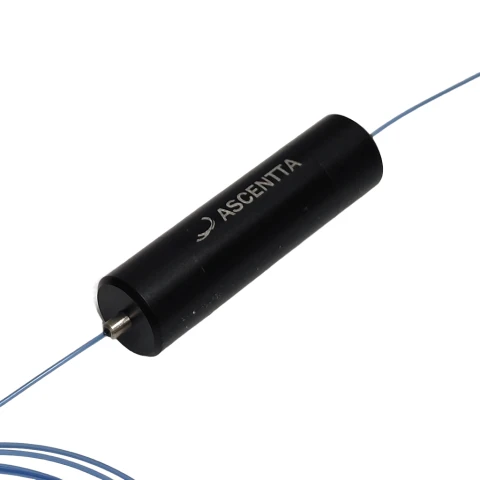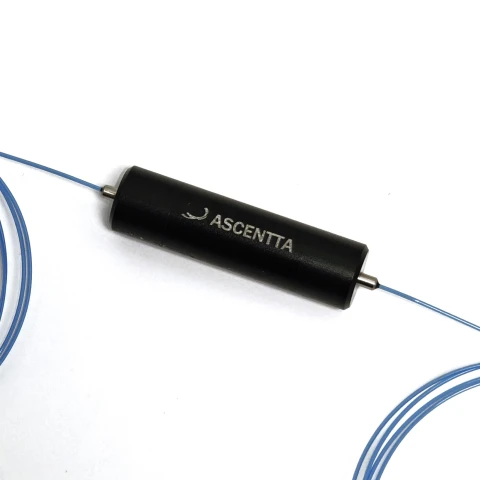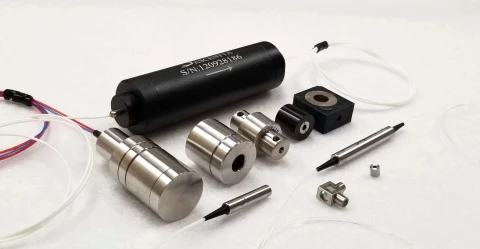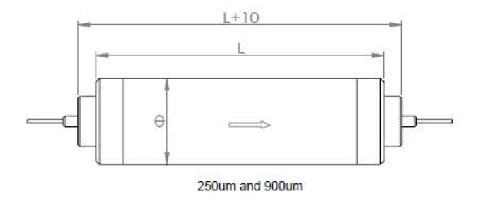Single-Mode Polarization-Insensitive TGG Fiber Isolator (532nm, 635nm, 780nm, 850nm)
For pricing, technical or any other questions please contact the supplier
- No registration required
- No markups, no fees
- Direct contact with supplier
-
Ships from:
United States
-
Sold by:
-
On FindLight:
since 2020
Description
Ascentta’s Single-Mode Polarization-Insensitive TGG Optical Isolator is engineered to deliver stable, high-performance isolation for optical systems that operate in the visible and near-infrared range. Standard models are available for popular wavelengths such as 532 nm, 635 nm, 650 nm, 780 nm, 850 nm, 980 nm, 1030 nm, and 1060 nm. We can also manufacture for customized wavelengths within this range to meet unique application needs. By blocking back reflections and feedback, the isolator helps protect light sources and maintain signal quality in systems used for fiber communications, biomedical imaging, photonics research, and optical sensing.
This isolator features a single-mode, polarization-insensitive design that ensures consistent performance regardless of the input light’s polarization state. Each unit is built with precise optical alignment and excellent long-term stability, making it a reliable component for integration into lasers, interferometers, optical amplifiers, and precision measurement instruments.
Because every optical setup has different requirements, the TGG isolator can be tailored to specific needs. Options include custom wavelengths, fiber types, cable jackets (bare fiber, loose tube, or 3mm cable), connectors (FC/APC, FC/PC, SC/APC, LC/APC, or other), and fiber lengths. Whether it is used in a telecom network, an industrial laser process, a diagnostic instrument, or a laboratory prototype, this isolator can be configured for seamless integration and dependable performance in demanding environments.
Single-Mode Polarization-Insensitive TGG Fiber Isolator (532nm, 635nm, 780nm, 850nm)
Specifications |
|
|---|---|
| Type Of The Device: | Isolator |
| Operating Wavelength: | 850 nm |
| Max Power: | 0.15 W |
| Min Isolation: | 24 dB |
| Typical Isolation (23°C, All SOP): | 28 dB |
| Insertion Loss (All SOP): | 1.5 dB |
| PDL (Max.): | 0.18 dB |
| PMD (Max.): | 0.2 ps |
| Return Loss (Min.): | 45 dB |
| Optical Power Handling (Max.): | 150 mW |
| Package Dimension: | Φ 24 mm × L 80 mm |
| Operating Temperature: | 10 - 50 °C |
| Storage Temperature: | 0 - 60 °C |
Features
- Wide Wavelength Range: Available in multiple wavelengths including 532nm, 635nm, 650nm, 780nm, 850nm, 980nm, 1030nm, and 1060nm, catering to diverse optical applications.
- High Isolation: Typical isolation values range from 26dB to 30dB, ensuring minimal signal interference and enhanced performance.
- Low Insertion Loss: Maximum insertion loss as low as 1.2dB, optimizing signal transmission efficiency.
- Minimal Polarization Dependent Loss (PDL): PDL values as low as 0.15dB, ensuring stable performance across different polarization states.
- Low Polarization Mode Dispersion (PMD): Maximum PMD of 0.2ps, supporting high-speed data transmission applications.
- High Return Loss: Minimum return loss of 45dB, reducing back reflections and improving system integrity.
- Robust Optical Power Handling: Capable of handling optical power up to 250mW, suitable for high-power applications.
- Compact Design: Cylindrical package dimensions ranging from Φ21xL60mm to Φ24xL95mm, facilitating easy integration into various systems.
- Temperature Resilience: Operating temperature range from 10°C to 50°C and storage range from 0°C to 60°C, ensuring reliability in varying environmental conditions.
- Customizable Options: Custom configurations available for wavelength, fiber type, cable type, fiber length, connector type, and package options to meet specific application needs.
Applications
- Telecommunications: Used in fiber optic communication systems to prevent back reflection and interference, ensuring signal integrity and efficiency.
- Medical Equipment: Integrated into laser systems for surgery and diagnostics, protecting sensitive components from reflected laser light.
- Medical Equipment: Applied in surgical and diagnostic laser setups to control interference and reduce sensitivity to back-reflection.
- Research and Development: Essential in laboratories for experiments requiring precise control of light paths, such as spectroscopy and photonics research.
- Industrial Applications: Utilized in manufacturing processes involving laser cutting, welding, and material processing to enhance system performance and safety.
- Military and Aerospace: Applied in defense and aerospace systems for secure and reliable optical communication and sensor systems.
- Optical Instrumentation: Critical in the design of optical instruments like interferometers and spectrometers, where isolation of light paths is necessary.
Frequently Asked Questions
The optical isolator is designed to prevent reflected light from traveling back into the laser source, which can cause instability and damage.
The optical isolator supports single-mode operation at wavelengths of 532nm, 635nm, 650nm, 780nm, 850nm, 980nm, 1030nm, and 1060nm. Customized wavelengths are also supported.
The maximum optical power handling capacity varies by wavelength, ranging from 50mW at 532nm to 250mW at 980nm, 1030nm, and 1060nm.
The maximum insertion loss varies by wavelength, from 2.3dB at 532nm to 1.2dB at 980nm, 1030nm, and 1060nm.
The operating temperature range is 10°C to 50°C, and the storage temperature range is 0°C to 60°C.
Adding connectors can affect the insertion loss (IL), return loss (RL), and polarization dependent loss (PDL) of the optical isolator.
The package dimensions vary by wavelength, with diameters of either Φ21mm or Φ24mm and lengths ranging from 60mm to 95mm.




